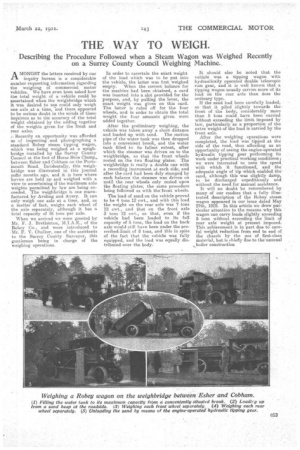THE WAY TO WEIGH.
Page 17

If you've noticed an error in this article please click here to report it so we can fix it.
Describing the Procedure Followed when a Steam Wagon was Weighed Recently on a Surrey County Council Weighing Machine.
AMONGST the letters received by our inquiry bureau is a considerable number requesting, information regarding the weighing of commercial motor vehicles, We have even been asked how the total weight of a vehicle could be ascertained when the weighbridge which it was desired to use could only weigh one axle at a time, and there appeared to be serious doubt in the minds of these inquirers as to the accuracy of the total weight obtained by the adding together of the weights given for the front and rear axles.
". Recently an opportunity was afforded us of inspecting and photographing a standard Robey steam tipping wagon, which was being weighed at a weighbridge installed by the Surrey County Council at the foot of Horse Shoe Clump,. between Esher and Cobham on the Portsmouth Road. Incidentally, this weighbridge was illustrated in this journal soffie months ago, and it is here where lorries are held up and weighed with a view to ascertaining if the maximum axle weights permitted by law are being ex. ceeded. The weighbridge is one manufactured by Aveling and Avery. It can .only weigh one axle at a time, and, as a matter of fact, weighs each wheel of the axle separately, although it has a total capacity of 16 tons per axle.
When we arrived we were greeted by Mr. F. J. Bretherton, M.I.A.E., of the Robey Co., and were introduced to Mr. F. V. Chalker, one of the assistants to the Surrey County Surveyor, this gentleman being in charge of the weighing operations.
In order to ascertain the exatt weight of the load which was to be put into the vehicle, the latter was first weighed empty. When the correct balance for the machine had been obtained, a card was inserted into a slot provided for the purpose, and, by puffing the lever, the exact weight was given on this card. The latter is ruled off for the four wheels' and in order to obtain the total
t, weigh the four amounts given were added together.
After the preliminary weighing, the vehicle was taken away a short distance and loaded up with sand. The suction pipe of the water tank was then dropped into a convenient brook, and the water tank filled to its fullest extent, after which the steamer was driven on to the weighbridge, so that the front wheels rested on the two floating plates. The weighbridge is really a double one with a recording instrument at each side, and after the card had been duly stamped by each balance the steamer was driven on until the rear wheels only rested upon the floating plates; the same procedure being followed as with the front wheels.
The load of sand on the vehicle proved to be 4 tons 12 cwt., and with this load the weight on the rear axle was 7 tons 12 cwt., and that on the front axle 3 tons 12 cwt., so that, even if the vehicle had been loaded to its full capacity of 5 tons, the load on the back axle would still have been under the prescribed limit of 8 tons, and this in spite of the fact that the vehicle was fully equipped, and the load was equally distributed over the body.
It should also be noted that the vehicle was a tipping wagon with hydraulically operated double telescopic ram gear, and it is well known that a tipping wagon usually carries more of its load on the rear axle than does the ordinary type.
If the sand had been carefully loaded, so that it piled ' slightly towards the front of the body, considerably more than 5 tons could have been carried without exceeding the limit imposed by law, particularly as a proportion of the extra weight of the load is carried by the front axle.
After the weighing operations were completed, the load was tipped at the side of the road, thus affording us an opportunity of seeing the engine-operated hydraulic tipping gear performing its work under practical working conditions ; we were interested to note the speed with which it functioned, and the adequate angle of tip which enabled the sand, although this was slightly damp, to be discharged expeditiously and without the need for manual assistance.
It will no doubt be remembered by many of our readers that a fully illustrated description of the Robey steam wagon appeared in our issue dated May 27th, 1919. In this article we drew particular attention to the reasons why this wagon can carry loads slightly exceeding 5 tons without exceeding the limit of rear axle weight at present imposed. This achievement is in part due to careful weight reduction from end to end of the chassis by the use of first-class material, but is chiefly flue to the'unusual ,boiler construction
































